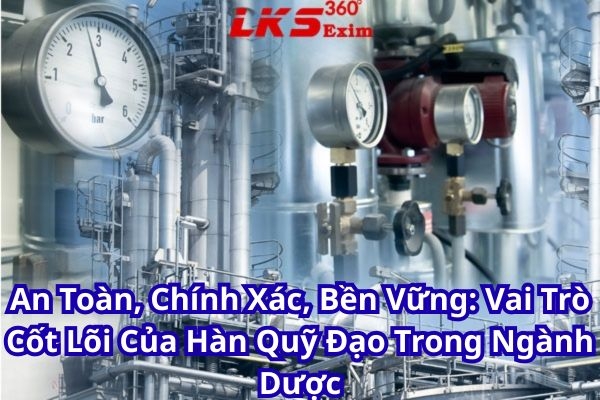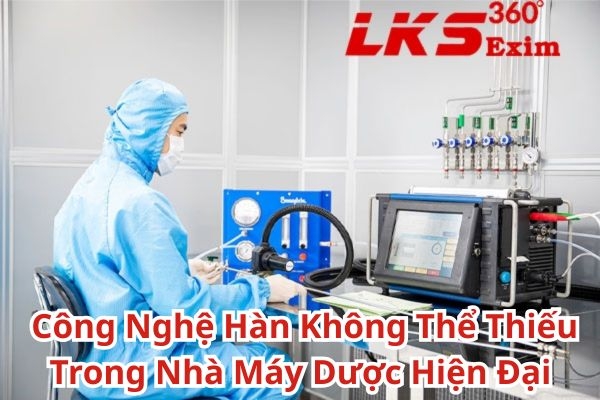Blog
Importance of Orbital Pharmaceutical Welding in the Industry
Orbital pharmaceutical welding stands as a pivotal technology in the modern pharmaceutical industry. This sophisticated process, where precision and sterility are paramount, plays a critical role in the fabrication of piping systems and vessels used in drug manufacturing. By employing automated, orbital welding techniques, pharmaceutical companies can achieve high-quality, consistent welds that meet stringent regulatory standards for cleanliness and contamination control.
The importance of orbital pharmaceutical welding in the industry : ensures the integrity and purity of the pipelines that transport sensitive and costly pharmaceutical products. In an era where pharmaceutical manufacturing is increasingly complex and regulated, the reliability and efficiency of orbital welding technology are indispensable. This article of LKS 360 EXIM explores orbital pharmaceutical welding impact on product quality, safety, and overall manufacturing efficiency in the pharmaceutical industry.
Benefits of Orbital Pharmaceutical Welding
Orbital pharmaceutical welding, a revolutionary technique in the world of medical manufacturing, is transforming how we approach the creation and assembly of critical pharmaceutical components. This method, known for its high precision and consistency, stands as a beacon of innovation, ensuring that the products vital to our health and wellbeing are produced with utmost care and quality.
High Precision and Consistency
At the heart of orbital pharmaceutical welding lies its unparalleled precision and consistency. This advanced welding technique utilizes mechanized processes, allowing for extremely accurate welds that human hands could never achieve. This precision is not just a matter of finesse; it's a critical necessity in pharmaceutical manufacturing where even the slightest deviation can have significant implications. The consistency provided by this method means each weld is as perfect as the last, ensuring uniformity in production that is essential for both efficacy and safety.
Improved Quality Control
Quality control is paramount in the pharmaceutical industry, and orbital welding elevates this aspect to new heights. With its automated and controlled processes, this technique reduces the risk of human error, a crucial factor in an industry where mistakes can have serious consequences. The welding process is closely monitored, with real-time feedback mechanisms in place, ensuring that each component meets the stringent quality standards required in pharmaceutical applications. This level of control translates to a higher degree of trust and reliability in the products produced, ultimately benefiting end-users who rely on these medical necessities.
Compliance with Regulatory Standards
The pharmaceutical industry is heavily regulated to ensure that products are safe and effective. Orbital pharmaceutical welding shines in its ability to comply with these rigorous regulatory standards. The precision and control of this welding method mean that products are consistently manufactured to meet the strict specifications set by regulatory bodies. This compliance is not just about adhering to rules; it's about ensuring the highest level of safety and efficacy for pharmaceutical products, which in turn builds consumer confidence and trust in these essential items.
Cost-Effectiveness
While the technological sophistication of orbital pharmaceutical welding might suggest high costs, it is surprisingly cost-effective in the long run. The efficiency and speed of this automated welding process reduce labor costs and production time. Additionally, the reduction in errors and rework, thanks to the high precision and quality control, translates to savings in materials and resources. This cost-effectiveness is a significant advantage for pharmaceutical companies, allowing them to allocate more resources to research and development, ultimately benefiting consumers with better and more affordable healthcare products.
Techniques and Equipment of Orbital Pharmaceutical Welding
Orbital pharmaceutical welding, a cornerstone in the realm of medical manufacturing, is not just a process but an art form, blending state-of-the-art techniques and specialized equipment. This complex yet fascinating welding method utilizes a trio of key components: weld heads, power supplies, and gas control systems. Each of these elements plays a pivotal role in achieving the precision and efficacy for which this method is renowned.
Weld Heads: The Precision Craftsmen
Imagine a skilled artisan with the ability to perform the most delicate tasks with unerring accuracy – that's what weld heads are to orbital pharmaceutical welding. These heads are the frontline warriors, directly engaging with the material to be welded. Designed to maneuver around various diameters and configurations, weld heads offer unmatched precision. They are engineered to handle the intricacies of pharmaceutical tubing, ensuring that each weld is flawless and meets the stringent demands of the medical industry. The adaptability of these weld heads to different materials and shapes is a testament to the sophistication of this technology, making it a key player in the manufacturing process.
Power Supplies: The Heartbeat of Welding
If weld heads are the artisans, then power supplies are the heartbeats of the orbital welding process. These power supplies provide the energy required to create the welds, and their role cannot be overstated. They are designed to deliver precise and controlled power output, ensuring that the welds are not just strong, but also consistent in quality. The advanced technology in these power units allows for fine-tuning of the welding parameters, enabling customization for different materials and thicknesses. This adaptability is crucial in pharmaceutical welding, where diverse materials and strict specifications are the norms.
Gas Control Systems: The Invisible Protectors
Lastly, the unsung heroes of orbital pharmaceutical welding - the gas control systems. These systems play a vital role in shielding the weld area from atmospheric contamination. In the highly sensitive world of pharmaceutical manufacturing, even the smallest impurity can compromise the integrity of a weld. Gas control systems ensure a clean and controlled environment, using inert gasses like argon to protect the weld zone. This protection is critical in maintaining the purity and quality of the welds, which in turn, ensures the safety and efficacy of the pharmaceutical products.
=> See more articles on the same topic at:
=> Orbital Welding For Pharmaceutical Tubing ( Orbital Pharmaceutical)
=> Maximizing Efficiency and Quality with Orbital Pharmaceutical Welding
Orbital pharmaceutical welding is more than just a manufacturing process; it’s a progress of precision, control, and innovation. This article appreciates the complexity and importance of this method in the pharmaceutical industry. Share this insight with others who are curious about the cutting-edge technology in medical manufacturing, and stay tuned for more engaging content that unravels the mysteries of modern manufacturing techniques.
In conclusion, the benefits of orbital pharmaceutical welding are clear and multifaceted. From its unmatched precision and consistency to its adherence to regulatory standards, and from its enhanced quality control to its cost-effectiveness, this technique represents a significant leap forward in pharmaceutical manufacturing. Please contact LKS 360 EXIM if you need to provide information and solutions about orbital pharmaceutical welding quickly and accurately.
LKS 360 Import Export Trading Service Co., Ltd
Hotline: 02866.503.603
Website: lks360exim.com
Blog









